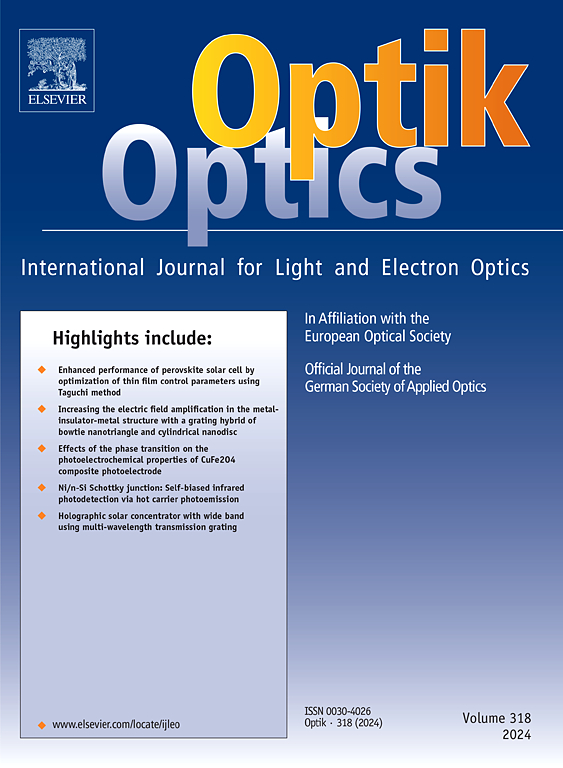星形氧化铟锡基纳米光子透明光学天线
IF 3.1
3区 物理与天体物理
Q2 Engineering
引用次数: 0
摘要
设计和研究了一种星形氧化铟锡基透明等离子体纳米天线,用于二氧化硅衬底的纳米光子应用。用德鲁德公式和洛伦兹公式分析了氧化铟锡和二氧化硅在零波长附近的色散特性和ε。利用CST Microwave Studio通过设计参数(如导电贴片的长度、宽度和衬底)对纳米结构的设计进行优化。优化结果表明,所提出的透明导电贴片工作在29.87 太赫兹,增益为7.04 dBi。此外,该天线的S11系数为- 41.84 dB,谐振处带宽为4 THz。该透明天线在E场和H场的场增强系数分别为375和240。推导了透明天线的纳米电路,并用该模型对仿真结果进行了验证。所设计的透明天线具有等离子共振特性,适合应用于纳米光子集成电路中。本文章由计算机程序翻译,如有差异,请以英文原文为准。
Star-shaped indium tin oxide based transparent optical antenna for nanophotonic applications
A star-shaped indium tin oxide-based transparent plasmonic nano-antenna is designed and studied for nanophotonic applications using a silicon dioxide substrate. The dispersive properties and epsilon near zero wavelength of the indium tin oxide and silicon dioxide are analysed using the Drude and Lorentz formulas. The design of the nanostructure is optimised using CST Microwave Studio through the design parameters such as length, width of the conducting patch and substrate. The optimised results exhibit that the proposed transparent conducting patch is operating at 29.87 THz with a gain of 7.04 dBi. Further, the S11 coefficient of the proposed antenna is −41.84 dB with a bandwidth of 4 THz at the resonance. The proposed transparent antenna exhibits field enhancement factors of 375 and 240 for E and H fields, respectively. The nanocircuit of the transparent antenna is derived and the simulated results are validated using the proposed model. The designed transparent antenna is suitable to use in the nanophotonic integrated circuits since it exhibits plasmonic resonance characteristics.
求助全文
通过发布文献求助,成功后即可免费获取论文全文。
去求助
来源期刊

Optik
物理-光学
CiteScore
6.90
自引率
12.90%
发文量
1471
审稿时长
46 days
期刊介绍:
Optik publishes articles on all subjects related to light and electron optics and offers a survey on the state of research and technical development within the following fields:
Optics:
-Optics design, geometrical and beam optics, wave optics-
Optical and micro-optical components, diffractive optics, devices and systems-
Photoelectric and optoelectronic devices-
Optical properties of materials, nonlinear optics, wave propagation and transmission in homogeneous and inhomogeneous materials-
Information optics, image formation and processing, holographic techniques, microscopes and spectrometer techniques, and image analysis-
Optical testing and measuring techniques-
Optical communication and computing-
Physiological optics-
As well as other related topics.
 求助内容:
求助内容: 应助结果提醒方式:
应助结果提醒方式:


